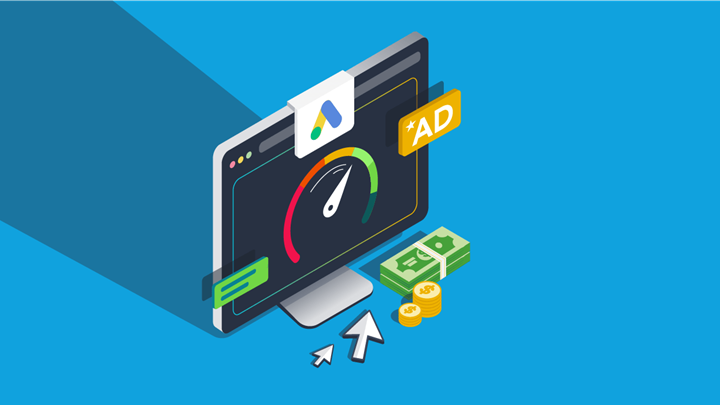How can I increase my Google Quality Score?
- By Kyra Kuik - Jul 30, 2019 Ads
Whether you’re a PPC pro or brand new to Google Ads, Quality Score can be a major obstacle in achieving cost efficient ad campaigns. Like most things Google Ads, it can be tricky to figure Quality Score out, but the time you invest will be well worth the benefits of a higher scoring ad groups.
What is Google’s Quality Score?
Let’s start with the basics. Quality Score is a score that Google gives advertisers that tells them how relevant Google believes their ads, keywords, and landing pages are. Quality Score is measured from 1-10, where 1 is the worst and 10 is the best possible score.
Google sets a minimum benchmark Quality Score, which is 5. Anything above 5 is considered a positive quality score, with 7+ being good.

Understanding a scale of 1-10 isn’t exactly rocket science, but what’s more difficult is understanding what a 10 ads experience actually looks like. Fortunately, Google has given examples in the past of what a high Quality Score experience looks like:
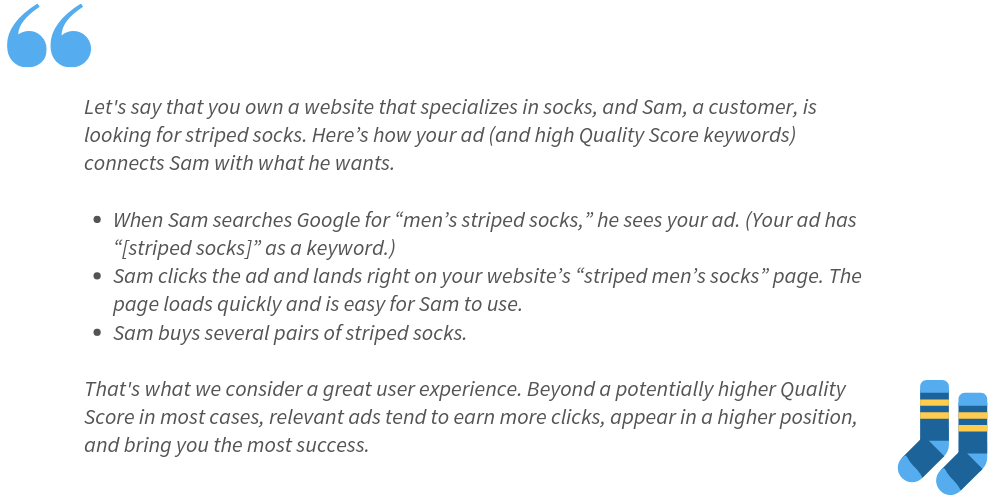
Why does a good Quality Score matter?
Google calls Quality Score “a guide, not a precise metric,” and encourages businesses to focus on creating high quality ads regardless of QS. And of course businesses should focus on high-quality, relevant ads. However, Quality Score is very much used as a precise metric and should be treated as such.
A good Quality Score is vital to your PPC success for two reasons:
- Google will reward high QS with higher ad rank—meaning you get more and better ad placements.
- A high QS means your cost per click (CPC) will be reduced, so you pay less for clicks. On the flip side, a low Quality Score means you will be penalized and pay more for clicks.
An in-depth audit of thousands of PPC accounts has shown that a Quality Score of 1 means an advertiser can end up paying 400% more for a click, while a score of 10 means advertisers can see up to a 50% discount.
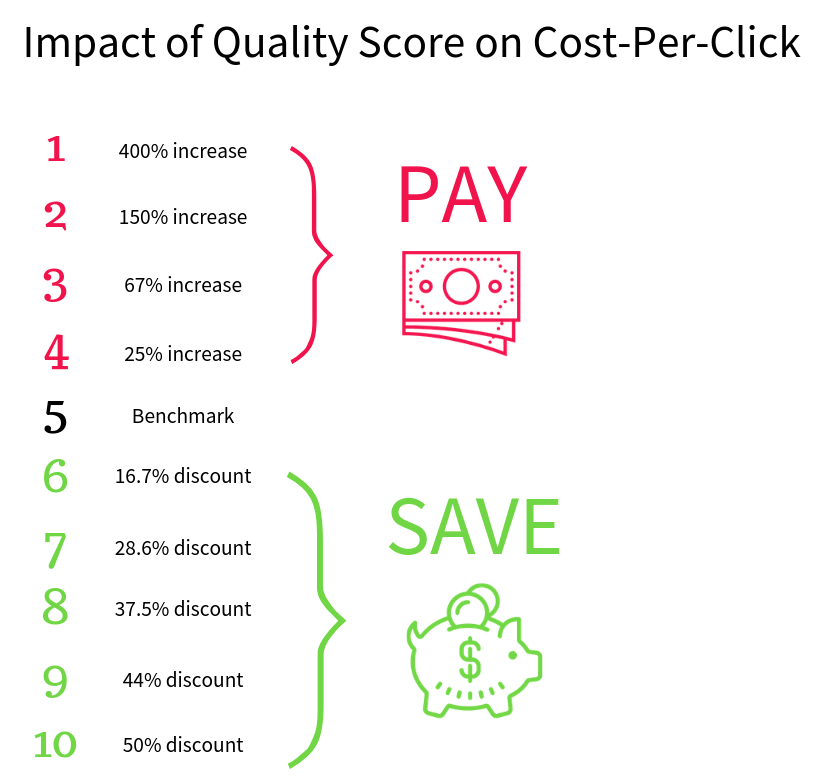
Given how expensive bidding on some keywords can be, saving 50% per click is a massive help to your ads budget—not to mention it can get you a much better ad rank.
Quality Score components
Alright, now let’s dive into the different components of your Quality Score. According to Google, there are three “big” components of QS:
- Expected click-through rate (CTR): How likely is someone to click your ad when Google serves it for the keyword they type in?
- Ad relevance: Does the ad make sense to appear when someone searches for a particular keyword?
- Landing page experience: Does the information on the landing page correspond to what the ad is offering, and vice versa?
Each of these three components contribute to your Quality Score, but not equally. Google hasn’t made it explicitly clear how the “big” categories are weighted, but one attempt at reverse engineering the formula found that:
- Landing page experience accounts for 39%
- Expected CTR accounts for 39%
- Ad relevance accounts for 22%
While Google advises advertisers to focus on those three main components, they have also admitted that other things can affect Quality Score, including a user’s device, ad relevance in relation to the user’s intentions, and performance of related keywords (this only applies if you launch new keywords). It’s easy to forget that Google is out to make a profit on ads (in 2018, Google’s ad revenue was a whopping $116.3 billion—yes, billion with a B). So, it’s safe to say that Google has a deep interest in keeping their Quality Score formula secret.
How can I see my Quality Score with Siteimprove?
Figuring out your Quality Score at an account, campaign, and keyword is straight forward with Siteimprove. Form the main dashboard, navigate to Ads > Quality Score Analysis. From here, you can see a summary of your Quality Score, your historical QS, and the breakdown of the three big components of quality score.
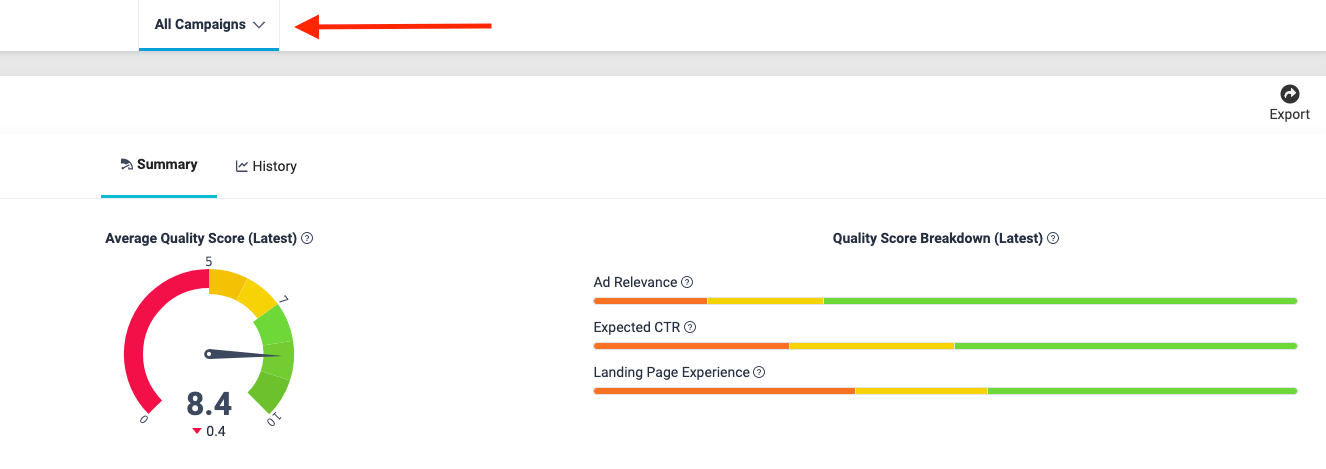
Select All Campaigns to see an overview at a campaign or account level. Scroll down to drill into Quality Score details on a campaign level.
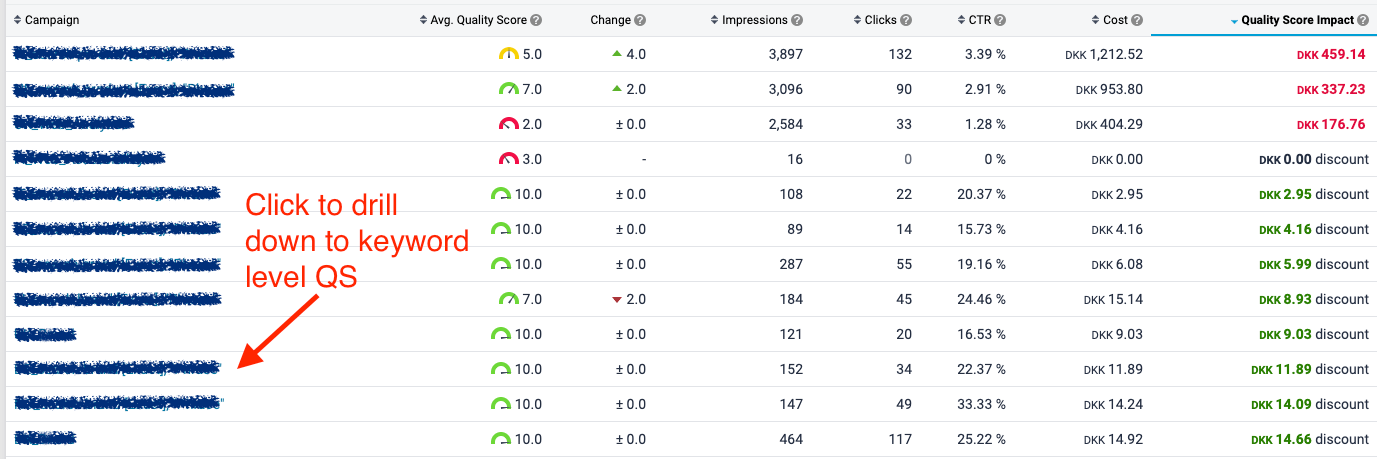
From here, you can click into a campaign to see your Quality Score on a keyword level, including cost penalties or discounts:

How to improve your Quality Score
Now onto the fun stuff—improving and optimizing! When it comes to boosting your Quality Score, there are both big and small changes you can focus on.
Tighten your ad groups
Before you can start improving the three big components of your Quality Score, you need to take a look at your ad groups. If they contain too many keywords that are only loosely related, it will be difficult to improve your ad relevance and CTR. Google has formerly recommended 10-20 keywords per ad group, but most industry experts (ourselves included) agree that’s way too many keywords in a single ad group, because it doesn’t allow you to be specific enough in your ad copy or landing pages.
For ultra-specific keyword groups, try using the SKAG approach (single keyword ad groups).
Like the name implies, SKAGs are ad groups that contain only one keyword. By focusing on one keyword and using different match types, you gain greater control over your ad relevance—which greatly increases the chance of a click on your ad.
To start creating SKAGs, choose one keyword (e.g. striped socks), then add your keyword as modified broad match, phrase match, and exact match:
- +striped +socks
- "striped socks"
- [striped socks]
Next, add your negative keywords, which ensures your ad group is only targeted to its corresponding keyword.
Then, you can create another SKAG for your next keyword, and so on. For each of your SKAGs, create 3-5 ad variants, so you can see which ones perform best.
Once you’ve created your SKAGs, you can then tailor your ad copy to each keyword. Try adding your keyword in the URL slug, Headline 1, Description 1, and double check that you have a CTA in your description copy.
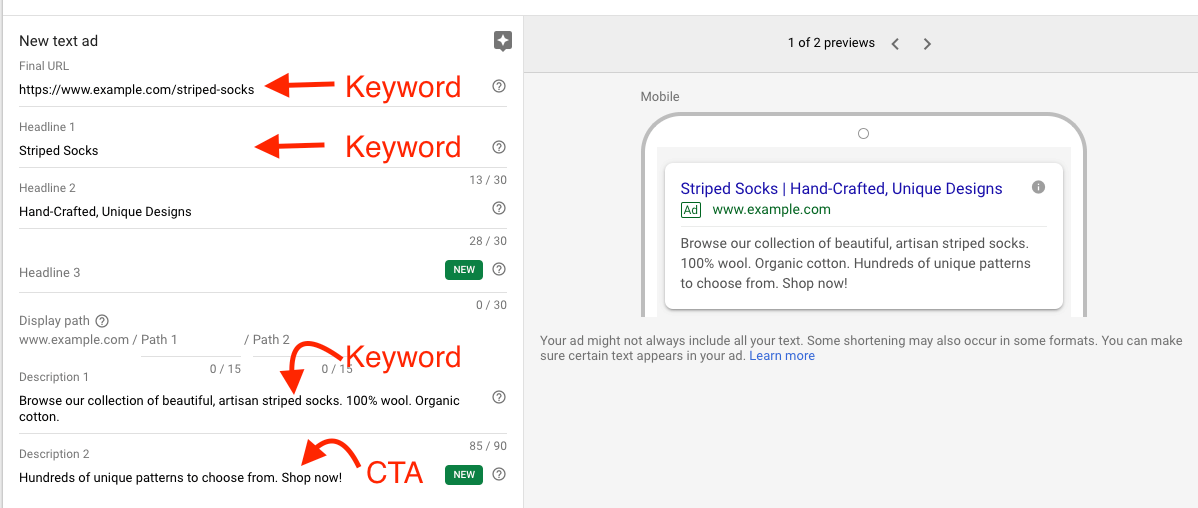
Increase ad relevance
By creating SKAGs and tailoring your ad copy to each keyword, you’ve already taken a huge step towards simplifying your ad relevancy. Beyond that, there are a few key ways you can start increasing your ad relevance.
- Never forget search intent: This is hugely important for ad relevance. Search intent is the why behind each search. Is a user looking for information? To buy? To learn something? Keep this intent at the heart of everything in your ads: your ad groups, copy, creatives, CTA, landing page, etc. If you give users what they want, your ad relevancy, CTR, and ultimately, Quality Score will dramatically increase.
- Create a red thread of keywords: Even if you don’t use SKAGs, you should create a red-thread for your target keywords. Make sure your keywords are in your ad copy and on your landing pages.
- Think about your creatives: Use ad creatives that speak to your target audience. Make sure your creatives tie together with the ad copy, CTA, and search intent.
- Address low-quality keywords: If you have keywords that are underperforming in your ad groups, consider moving them to their own ad group where you can create more relevant ads for them.
- Use negative keywords: Adding negative keywords to your ad groups is an easy way to weed out searches you know you don’t want your ad to appear for.
Boost click-through rate
If you’ve created more targeted ad groups, and worked on your ad relevance, then increasing your CTR becomes much easier. Start driving more clicks by using the following techniques:
- Use ad extensions: There are both manual and automated ad extensions. Use them to your advantage whenever you can, because ad extensions increase your CTR, as well as increase the physical size of your ads.
- Run branded keyword campaigns: The CTR for branded keywords is much higher than average. Running branded campaigns helps increase your overall CTR, which will boost Quality Score.
- Run geo-targeted campaigns (if it makes sense for you): Geo-targeted ads have a CTR that’s about twice as high as non-targeted ads. Of course you should only do this if it makes sense for your product/service, but it can be an effective way to boost your account CTR.
- Test different CTAs: Use your ad variants to test different CTAs. Try using words that create a sense of urgency or inspire action on the corresponding landing page.
- Get really specific: Try getting very specific in your ad copy. Highlight your unique selling points, features, benefits, price, etc.
Improve landing page experience
The final piece of the Quality Score puzzle is landing page experience. Again, if you’ve done the work of improving the other areas of your campaigns, this part will be easy.
- Search intent is everything: Search intent is arguably most important when talking about your landing page experience. Align your ad copy, benefits, and CTA with the user’s search intent, then give the user what you promised them in your ad copy.
- Keep it simple: Don’t overwhelm the visitor: only include one CTA, keep the content succinct and on-point, simplify forms as much as possible, and make it easy to navigate to other pages on your site.
- Test different landing pages: experiment with different layouts, copy, etc. on your landing pages, so you can optimize on a granular level.
- Don’t keyword stuff: Hopefully this is an obvious one: you shouldn’t overload your landing page with your target keywords. Sprinkle them throughout where it makes sense but focus on solving users’ needs.
- Increase page speed: Your page load time drastically affects user experience on your site—not to mention conversion rates! Users start to lose patience after just two seconds of load time, so make sure your landing pages load within that timeframe.
- Think about mobile: According to Google, “the user’s device is taken into account when ad quality is calculated. Make sure your site experience is optimized for mobile.” This can affect everything from site speed on mobile to mobile navigation. Over half of web traffic now comes from a mobile device—so don’t neglect those clicks!
Key takeaways
Remember, when it comes to Quality Score, Google has a vested interest in keep the exact breakdown of your score secret. Do your own homework and, most importantly, pay close attention to the results of your Ads account. But if your Quality Score needs a quick fix, start with the following:
- Dramatically tighten up your ad groups
- Increase your ad relevancy by writing with your target keywords and users’ search intent in mind
- Run strategic campaigns to boost CTR, including branded keywords, ad extensions, and geo-targeted campaigns
- Create a better landing page experience by delivering what users want and keeping their experience fast and simple
